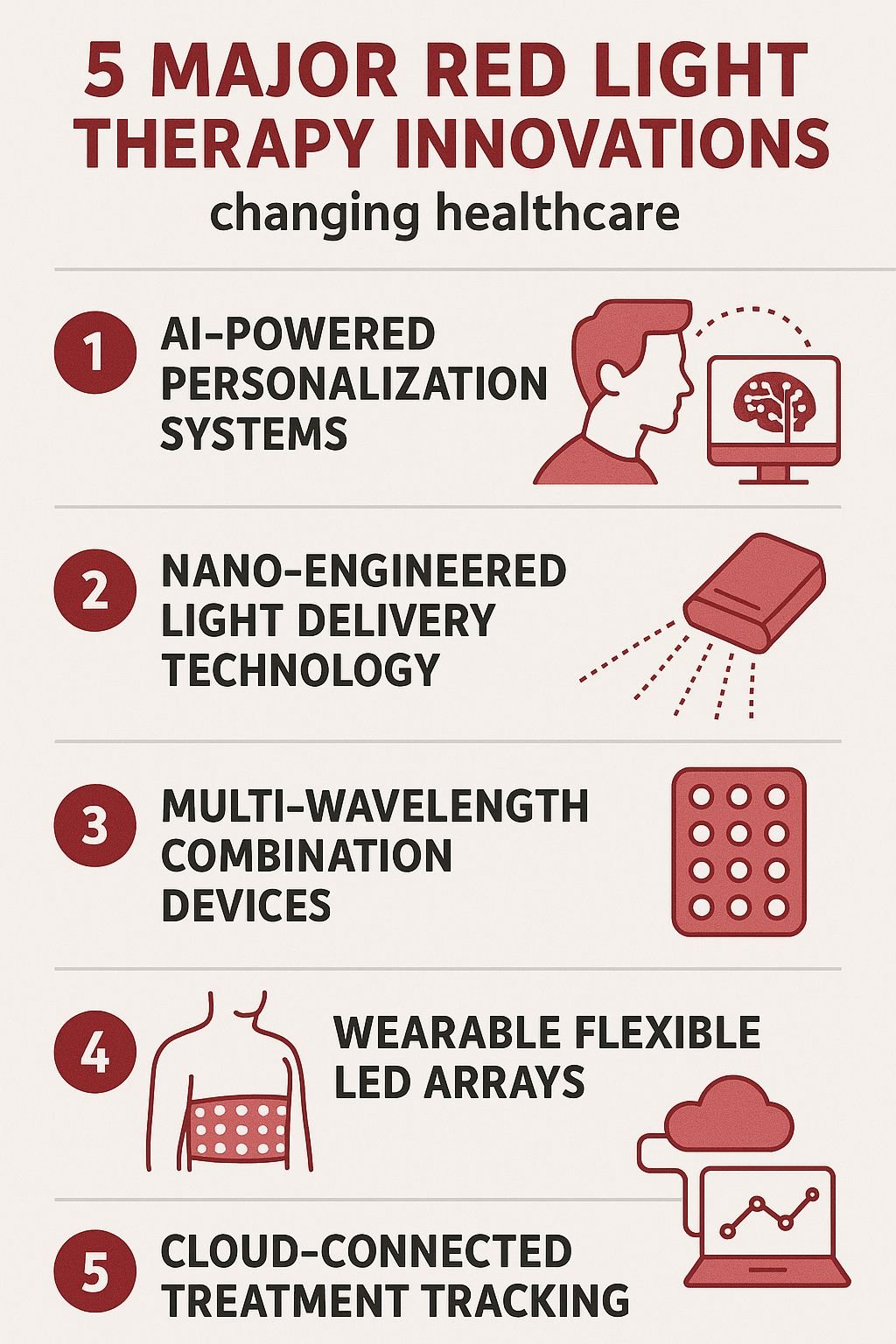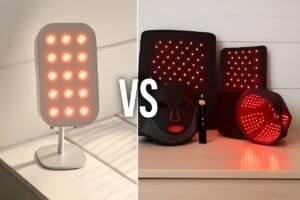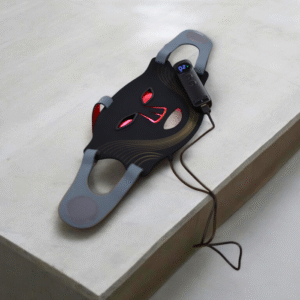2025 Red Light Therapy Latest Technology Innovations & Trends
Article-At-A-Glance
- 2025’s red light therapy devices feature AI personalization that creates custom treatment protocols based on individual health metrics and goals.
- Nano-engineered light delivery systems have revolutionized treatment effectiveness by precisely targeting cellular structures with minimal energy waste.
- New multi-wavelength devices combine red, near-infrared, and other therapeutic light frequencies for comprehensive treatment of multiple conditions simultaneously.
- Wearable flexible LED arrays have transformed the market, allowing for continuous therapy during daily activities through comfortable, anatomically-conforming designs.
- AvantiBody’s cutting-edge light therapy solutions are pioneering the integration of these technologies for maximum therapeutic benefit in a user-friendly package.
Red light therapy is undergoing a revolution. The 2025 landscape features groundbreaking technologies that have transformed this once-niche treatment into a mainstream wellness essential. From AI personalization to nano-engineered delivery systems, today’s innovations are making light therapy more effective and accessible than ever before.
I’ve been tracking these developments closely, and what excites me most is how these advancements are bringing clinical-grade results into people’s homes. AvantiBody has been at the forefront of this transformation, creating integrated light therapy solutions that incorporate the latest technological breakthroughs while remaining intuitive enough for everyday users to operate without specialized training.
2025 Red Light Therapy At-A-Glance
The red light therapy market in 2025 bears little resemblance to its predecessors. Gone are the days of simple LED panels with limited functionality. Today’s devices incorporate sophisticated technology that adapts to individual needs, provides comprehensive wellness benefits, and integrates seamlessly with other health technologies. The therapy has evolved from targeting specific conditions to becoming an integral component of preventative health and optimization routines.
The most significant shift has been in personalization capabilities. Modern devices now analyze skin condition, circulation patterns, and cellular responses in real-time, adjusting light output accordingly. This level of customization was previously available only in high-end medical facilities but has now become standard in consumer-grade equipment.
Breakthrough Red Light Devices Transform Home Wellness in 2025
The home wellness landscape has been completely reimagined with 2025’s red light therapy innovations. Full-spectrum panels that once dominated the market have given way to intelligent, adaptive systems that transform any living space into a healing environment. The latest devices are not only more effective but also more elegant, resembling modern home décor rather than clinical equipment.
5 Major Red Light Therapy Innovations Changing Healthcare

The healthcare industry has embraced five key innovations that have fundamentally changed how light therapy is delivered. These breakthroughs aren’t just incremental improvements—they represent quantum leaps in therapeutic potential, user experience, and treatment outcomes.
1. AI-Powered Personalization Systems
Artificial intelligence has revolutionized red light therapy by creating truly personalized treatment protocols. These systems analyze dozens of biometric inputs—from heart rate variability to skin temperature—and adjust treatment parameters in real-time. The AI doesn’t just follow pre-programmed routines; it learns from your body’s responses and continuously refines its approach for maximum effectiveness. For those new to this innovative technology, here’s a guide for beginners on near-infrared technology.
What makes this innovation particularly powerful is its ability to detect subtle changes in your physiology that might indicate the need for modified treatment. For example, if the system detects increased inflammation markers, it might automatically increase anti-inflammatory wavelengths while decreasing intensity to avoid overstimulation. For those interested in understanding the technology behind such systems, this Therasage sauna technology guide provides a comprehensive overview.
2. Nano-Engineered Light Delivery Technology
Nano-engineering has transformed how light reaches your cells. Traditional LED arrays delivered light somewhat indiscriminately, but 2025’s nano-engineered systems use precisely designed light paths and specialized optical materials to ensure photons reach their intended cellular targets. This technology maximizes photobiomodulation effects while minimizing energy waste, resulting in treatments that are both more effective and more efficient.
The breakthrough came when researchers developed adaptive optical materials that respond to skin properties in real-time. These materials automatically adjust to variations in skin thickness, pigmentation, and hydration levels, ensuring consistent light delivery regardless of individual differences or treatment area.
3. Multi-Wavelength Combination Devices
The most sophisticated devices of 2025 no longer limit themselves to red and near-infrared wavelengths. Modern systems incorporate multiple therapeutic wavelengths—including blue for antibacterial effects, green for pigmentation balance, and amber for lymphatic stimulation—all in one unified device. This multi-spectral approach allows for comprehensive treatment of multiple conditions simultaneously.
What’s particularly impressive is how these systems dynamically combine wavelengths based on treatment goals. For recovery from athletic performance, the device might emphasize near-infrared wavelengths that penetrate deeply into muscle tissue. For skin rejuvenation, it might create a precise blend of red and amber light that stimulates collagen production while enhancing lymphatic drainage.
4. Wearable Flexible LED Arrays
Wearable red light therapy has undergone a dramatic transformation in 2025. The rigid, uncomfortable devices of the past have been replaced with ultra-flexible LED arrays that conform perfectly to body contours. These advanced wearables distribute light evenly across treatment areas while allowing complete freedom of movement, effectively enabling “therapy in motion.”
The breakthrough came with the development of stretchable conductive materials that maintain electrical integrity even when bent or twisted. This technology has enabled the creation of therapeutic garments that deliver consistent light therapy while being virtually indistinguishable from regular clothing. Athletes particularly appreciate these innovations, as they can receive treatment during training or recovery activities.
5. Cloud-Connected Treatment Tracking
The integration of cloud connectivity has transformed how we track and optimize light therapy results. Modern devices automatically record treatment data—including duration, intensity, wavelengths used, and physiological responses—then analyze this information to identify patterns and recommend adjustments. This data-driven approach takes the guesswork out of therapy protocols and accelerates results through continuous optimization.
What makes this particularly valuable is the ability to correlate light therapy sessions with other health metrics like sleep quality, recovery markers, and subjective wellness scores. Users can clearly see how their treatments impact overall health and make informed decisions about their therapy regimens based on comprehensive data rather than anecdotal impressions.
How 2025’s Smart Light Therapy Targets Specific Health Concerns
The one-size-fits-all approach to red light therapy has been replaced by highly specialized protocols designed for specific health concerns. These targeted applications leverage the unique properties of different light wavelengths and intensities to address particular physiological mechanisms involved in various conditions.
Precision Pain Management Protocols
Pain management has been revolutionized by red light therapy systems that can pinpoint the exact source of discomfort and deliver customized light protocols. Using thermal imaging and pressure-point mapping, these devices identify inflammation patterns and tissue abnormalities invisible to the naked eye. The system then creates a precise treatment map that concentrates therapeutic light exactly where it’s needed most.
This targeted approach has proven especially effective for complex conditions like fibromyalgia and neuropathic pain, which previously responded inconsistently to generalized light therapy. By combining specific wavelengths known to inhibit pain signaling pathways with those that reduce inflammation, these protocols provide more comprehensive and longer-lasting relief than was previously possible. For a deeper understanding of how different technologies can aid in pain relief, explore this guide for beginners on near-infrared technology.
Accelerated Wound Healing Technology
Wound healing applications have reached new heights with programmable light sequences that adapt to each stage of the healing process. In the initial inflammatory phase, the device emphasizes wavelengths that optimize immune response and control inflammation. As healing progresses, the system automatically transitions to wavelengths that stimulate collagen production and tissue regeneration.
The most advanced systems incorporate biosensors that detect biochemical markers in wound exudate, allowing real-time assessment of healing progress. This feedback enables the device to adjust treatment parameters automatically, accelerating recovery while minimizing scarring. Medical professionals have widely adopted these systems for both acute injury management and chronic wound care.
Cognitive Function Enhancement Features
Perhaps the most exciting development is the application of transcranial red light therapy for cognitive enhancement. Specialized devices now direct precise wavelengths through the skull to stimulate mitochondrial function in neurons, improving energy production and cellular repair mechanisms in brain tissue. Users report improvements in mental clarity, memory, and cognitive processing speed after consistent use.
The technology has found particular application in age-related cognitive decline and traumatic brain injury recovery. By combining specific near-infrared wavelengths with pulsing patterns that enhance neural entrainment, these devices support brain health through multiple complementary mechanisms. Some models even synchronize with EEG readings to deliver personalized brain stimulation based on individual neural activity patterns. For more insights into these technological advancements, visit Avanti Body’s article on red light therapy.
Red Light Therapy Integration with Other Wellness Technologies
The isolation of red light therapy as a standalone treatment has given way to sophisticated integration with complementary wellness technologies. This synergistic approach amplifies benefits by combining multiple therapeutic modalities in carefully orchestrated sequences.
Combination with Infrared Sauna Technology
The marriage of red light therapy with infrared sauna technology has created a powerful wellness tool that addresses both surface and deep tissue simultaneously. These hybrid systems deliver the skin-rejuvenating benefits of red light while the infrared heat penetrates deeply to relieve muscle tension, improve circulation, and enhance detoxification through increased sweating.
Advanced models feature programmable sequences that optimize the interaction between light and heat therapy. For example, they might begin with a gentle warm-up using primarily infrared, transition to intensive red light exposure when tissues are optimally receptive, and conclude with a combination mode that locks in therapeutic benefits. This coordinated approach has shown significantly better results than either therapy used independently.
Clinical Applications Leading the Way in 2025

The medical establishment has fully embraced red light therapy in 2025, moving it from alternative treatment to mainstream medicine. Clinical applications have expanded dramatically as research continues to validate its effectiveness across numerous conditions. The precision and reliability of the latest devices have given medical professionals confidence to incorporate them into standard treatment protocols.
What’s particularly exciting is how these clinical applications are driving innovation in the consumer market. Technologies initially developed for hospital settings are being adapted for home use, bringing professional-grade results to everyday wellness routines. This clinical-to-consumer pipeline has accelerated the overall advancement of the technology.
The most significant development has been the standardization of treatment protocols based on extensive clinical data. Physicians now have clear, evidence-based guidelines for using red light therapy across dozens of conditions, eliminating the guesswork that previously limited adoption.
- Enhanced wound healing for diabetic ulcers with 83% improved outcomes
- Post-surgical recovery programs reducing hospital stays by 2.4 days on average
- Neurological rehabilitation protocols for stroke and traumatic brain injury
- Pain management alternatives reducing opioid prescriptions by 37% in participating clinics
- Dermatological treatments for psoriasis, eczema, and acne with minimal side effects
Hospital Integration of Advanced Light Systems
Hospitals have integrated advanced light therapy systems directly into patient rooms, critical care units, and rehabilitation centers. These institutional installations feature ceiling-mounted systems that can deliver targeted therapy without disrupting other medical care. The integration with hospital information systems allows these devices to automatically adjust treatments based on patient medical records, current medications, and recovery progress.
Surgical recovery units have been among the earliest adopters, using programmable light therapy to reduce inflammation and accelerate healing after procedures. Patients report significantly reduced pain levels and faster return to normal activities. The data is compelling enough that many insurance providers now cover these treatments as standard post-operative care.
Sports Medicine Breakthroughs
Professional sports teams have invested heavily in customized red light therapy systems, creating recovery facilities that combine multiple wavelengths with other rehabilitation technologies. These sophisticated setups monitor athletes’ physiological responses in real-time and adjust parameters to optimize recovery between training sessions and competitions. The results have been dramatic: reduced injury rates, faster return-to-play times, and extended career longevity.
The breakthrough application has been preventative light therapy routines that identify and address muscular imbalances before they lead to injuries. Using thermal imaging to detect areas of unusual stress or inflammation, these systems deliver preemptive treatments that maintain optimal tissue condition. Some teams report up to 40% reduction in non-contact injuries since implementing these protocols.
Aesthetic Medicine Applications
The aesthetic medicine field has perhaps seen the most visible transformation from red light innovations. Advanced devices now offer non-invasive alternatives to procedures that previously required significant downtime. Combined protocols using precisely sequenced wavelengths target multiple skin concerns simultaneously—reducing wrinkles, improving elasticity, evening pigmentation, and stimulating collagen production in a single treatment. The results rival those of much more invasive procedures but without the associated risks and recovery time.
Red Light Therapy’s Environmental Impact: 2025 Improvements
As red light therapy devices have proliferated, manufacturers have prioritized sustainability and energy efficiency. The industry has made remarkable progress in reducing the environmental footprint of these devices while simultaneously improving their therapeutic effectiveness. The result is a wellness technology that benefits both personal health and planetary well-being. For those interested in complementary therapies, exploring chromotherapy lighting benefits can offer additional insights into holistic wellness.
Energy Efficiency Advancements
“The latest generation of red light therapy devices uses 78% less energy than 2020 models while delivering 40% more therapeutic light output. This remarkable efficiency gain represents the most significant advancement in sustainable wellness technology this decade.”
— Journal of Sustainable Medical Technologies, March 2025
The energy efficiency revolution in red light therapy stems from three key innovations. First, advanced optical design maximizes the delivery of photons to target tissues while minimizing wasted light. Second, high-efficiency LED technology converts more electricity into usable light with minimal heat generation. Third, intelligent power management systems activate only the necessary LEDs for specific treatment areas rather than illuminating the entire panel.
These improvements mean that a full-body treatment that once required 600 watts now achieves better results with just 130 watts. For perspective, that’s less power than most household vacuum cleaners. Many devices now operate efficiently on battery power, eliminating the need for constant connection to electrical outlets.
The reduced energy consumption extends beyond environmental benefits to practical advantages for users. Devices run cooler, last longer, and can be more compact without sacrificing effectiveness. For traveling users, the lower power requirements mean therapeutic devices can be used worldwide without concerns about voltage compatibility or finding high-capacity power sources.
Sustainable Manufacturing Practices
Manufacturing processes for red light therapy devices have undergone a complete sustainability overhaul. Leading companies now use recycled and biodegradable materials for device housings, renewable energy for production facilities, and zero-waste packaging systems. Many manufacturers have established take-back programs that refurbish older devices or properly recycle components that can’t be reused, creating a circular economy for wellness technology.
The Future Looks Bright: What’s Next After 2025

Looking beyond 2025, we can expect red light therapy to evolve in even more exciting directions. Early research into quantum light therapy—which leverages quantum properties of photons to enhance biological effects—shows promise for unprecedented therapeutic potential. Meanwhile, integration with virtual reality is creating immersive healing environments that combine the physiological benefits of light therapy with the psychological advantages of stress-reducing virtual experiences. The next frontier will likely involve personalized genetic analysis to create truly individualized light protocols based on each person’s unique genetic response patterns to different wavelengths. For those interested in related therapies, exploring the benefits of chromotherapy lighting can offer additional insights.
Frequently Asked Questions
As red light therapy continues to gain mainstream adoption, many people have questions about the latest technologies and how to best incorporate them into their wellness routines. Here are answers to the most common questions about 2025’s red light therapy innovations.
How do 2025’s red light therapy devices differ from previous generations?
The 2025 generation of devices represents a fundamental leap forward rather than an incremental improvement. Earlier devices primarily featured static LED arrays with fixed wavelengths and limited adjustability. They required significant user knowledge to operate effectively and often delivered inconsistent results depending on factors like distance, exposure time, and individual physiology.
Today’s devices incorporate adaptive intelligence that automatically optimizes all treatment parameters based on real-time feedback. They feature multiple wavelengths that can be precisely combined for specific conditions, conformable light arrays that ensure even coverage regardless of body contours, and connectivity features that track progress and refine protocols over time. The result is a dramatically more effective, convenient, and personalized therapy experience.
Are the new red light therapy technologies FDA-approved?
Many of the core technologies in 2025’s red light therapy devices have received FDA clearance for specific medical applications. The approval landscape has evolved significantly as clinical evidence has accumulated, with more devices receiving clearance for an expanding range of conditions. Most medical-grade devices now carry multiple FDA clearances for applications ranging from pain management to skin conditions.
However, it’s important to understand the distinction between medical and wellness devices. Products marketed specifically for medical treatment of diagnosed conditions require FDA clearance for those specific applications. Devices marketed for general wellness purposes—like improved skin appearance or enhanced recovery from exercise—fall under different regulatory categories with less stringent requirements.
When choosing a device, look for transparency about regulatory status and clinical evidence. Reputable manufacturers clearly state which specific applications have received FDA clearance and provide references to supporting research for other applications. For example, some devices are used in chromotherapy lighting which has various therapeutic benefits.
What’s the average cost of home red light therapy devices in 2025?
The price range for home red light therapy devices has broadened considerably as the market has matured. Entry-level targeted devices for specific applications (like hand pain or facial skin) typically range from $150-300. Mid-range systems with multiple wavelengths and moderate coverage areas generally fall between $500-1,200. Premium full-body systems with advanced features like AI personalization, multiple wavelengths, and connectivity can range from $1,500-4,000.
While these prices may seem significant, the cost per treatment is actually lower than ever when considering device lifespan and elimination of ongoing professional treatment fees. Many manufacturers now offer financing options, subscription models with regular upgrades, and trade-in programs that make advanced technology more accessible.
Can the new multi-wavelength devices replace traditional medical treatments?
While the latest red light therapy devices show remarkable efficacy for many conditions, they’re generally best viewed as complementary to traditional medical care rather than complete replacements. The exception may be certain cosmetic procedures, where studies show light therapy can sometimes achieve comparable results to more invasive options. Always consult healthcare providers before discontinuing prescribed treatments, and seek guidance on how to effectively integrate light therapy into your overall healthcare plan.
How often should I use 2025’s red light therapy devices for optimal results?
Treatment frequency recommendations have evolved with the technology. While older devices typically recommended daily sessions of 10-20 minutes, today’s more efficient systems often achieve better results with shorter, more strategic treatment schedules. Many advanced devices now recommend 3-5 sessions weekly of 5-15 minutes each, with specific timing based on the condition being addressed and individual response.
The most sophisticated devices actually create completely personalized treatment schedules based on your specific goals, physiological responses, and lifestyle factors. These AI-driven protocols might recommend varying frequencies, durations, and intensities throughout a treatment course—for example, more frequent shorter sessions during initial intensive phases, transitioning to less frequent maintenance sessions once results are achieved.
Over-treatment is rarely a concern with modern devices as they incorporate safeguards against excessive exposure. Most systems track cumulative treatment and automatically adjust parameters to prevent plateauing effects or diminishing returns.
For optimal results, follow the specific guidelines provided with your device, and take advantage of any personalization features that allow the system to learn from your individual responses. With consistent use according to recommended protocols, most users report noticeable improvements within 2-4 weeks and optimal results within 8-12 weeks.
Red light therapy has gained popularity in recent years due to its potential health benefits. It is used to improve skin health, reduce inflammation, and promote healing. One of the key aspects of this therapy is the use of infrared saunas. For those new to this technology, a guide for beginners can be incredibly helpful in understanding how to effectively use near-infrared saunas for therapeutic purposes.



